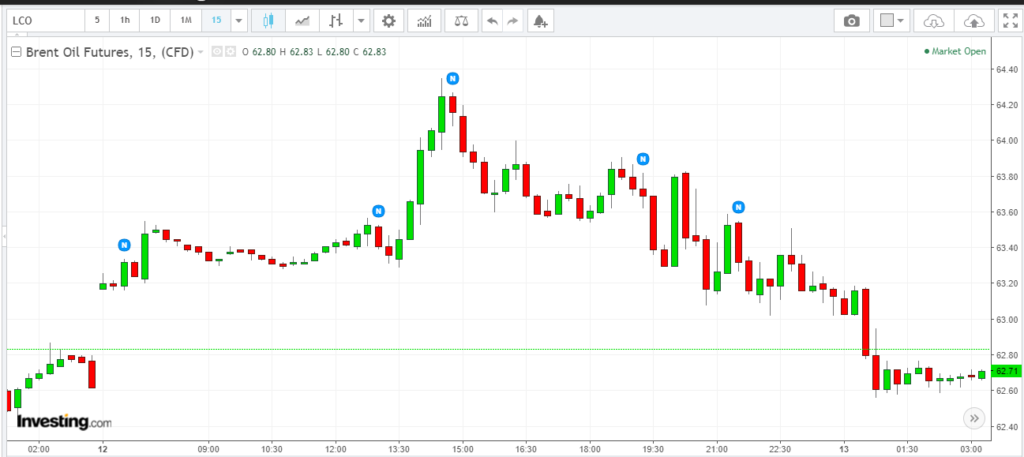Crude Oil
Oil prices ended the day little changed on the day as global equities began to recoup some losses from their biggest one-week decline in two years. Brent crude futures settled 20 cents lower at $ 62.59 /bbl. WTI, on the other hand, gained 9 cents to close at $59.29 /bbl.
The market had opened up with a gap as traders hoped that the crash of the last week was behind the markets. At London opening, speculative buying pushed Brent to as high as $ 64.35 /bbl.

However, these prices could not be sustained for long and prices had retreated to $ 63.50 /bbl by the time US markets were set to open. US traders inexorably sold till the gap between Friday’s close and Monday’s open was connected. However, there did not appear to be any further impetus to push prices lower.
Is the rally over?
This question is uppermost in all our minds as we watch the stock markets gyrate wildly. A week ago, we had presented our views on the topic in a seminar on Commodity Outlook 2018. Our views can be read on the presentation in the link.
While our view is decidedly bearish, it is worth taking a look at the other side of the coin as well which has been well presented by the Reuters analyst John Kemp. Most of the views below have been articulated by him. The emphases are ours.
While crude prices moved nearly $ 10 /bbl in the last move down, the one major confirmation that the rally is not over is yet standing strong. The positions held by money managers and funds is a massive 1,112 million barrels higher than the positions held by them at the end of June 2017.
While the combined net long position has been cut by a total of 63 million barrels in the last couple of weeks, it was raised by a 258 million barrels in the previous five weeks. In fact, the reduction in positions has only come out of a reduction in long positions. Even in this period, bearish short positions have fallen by 8 million barrels and are currently at the lowest levels since June 2014, when prices began to slide.
We have been watch the ratio of long positions to short positions at an extremely stretched level of 11:1. Even with the current reduction, the position still remains extremely stretched.
While commentators have identified several possible triggers for the correction in oil prices, including the sharp drop in U.S. equities, recent dollar strengthening and the unexpectedly rapid increase in U.S. shale production, the fact is that, at this level of stretching, almost anything or even nothing at all could have sparked the sell off.
In short, the story is not yet over!
Naphtha
The physical Asian naphtha crack gave up its gains of the previous week to settle at a 3 day low of $ 66.70 /MT yesterday. With the persisting supply overhang, we don’t envisage the cracks to surge in the near-term, save for a few spikes caused by temporary spot buying or transactions in the paper market.
The balance February paper naphtha crack is unchanged at $ 0.20 /bbl with the March crack slightly lower at $ 0.30 /bbl
Gasoline
Akin to naphtha, the Asian physical gasoline crack also settled at a 2 day low of $ 8.66 /bbl yesterday.
In the Platts Trading Window, Hin Leong continued with its buying spree purchasing five out of the six gasoline deals which were concluded.
The balance February paper 92 Ron gasoline crack is valued lower at $ 11.05 /bbl with March also down at $ 11.50 /bbl
Distillates
While the fundamentals for distillates continue unchanged, jet fuel is expected to be supported due to travel demand generated by the Chinese New Year being celebrated this week.
The Platts Windown was quiet with only one deal each of gasoil and jet getting concluded.
The balance February paper gasoil crack is unchanged at $ 13.90 /bbl. The 10 ppm crack is also unchanged at $ 14.60 /bbl. The February regrade has strengthened and is valued at $ 1.60 /bbl today.
The March paper gasoil crack remains at $ 14.00 /bbl. The 10 ppm crack is steady at $ 14.70 /bbl. The March regrade is valued higher at $ 0.85 /bbl today.
Fuel Oil
The fuel oil markets have been very quiet off-late with the Platts Trading Window witnessing no trades for a fourth consecutive day. Even otherwise, with the Lunar New Year celebrations underway, traders have not been active.
The February 180 cst crack is valued marginally higher at -$ 3.80 /bbl. The visco spread is unchanged at $ 0.85 / bbl.
The March 180 cst crack is also valued slightly higher at -$ 3.60 /bbl. The visco spread stays at $ 0.95 / bbl.
About this blog
This blog post attempts to give a top level summary of the Singapore market goings on to a person who seeks to obtain a directional sense of the market on a daily basis.
Disclaimer : All the views are the author’s personal views. These do not constitute an advice to buy or sell any commodity
